Max Ingrand
Maurice Max-Ingrand, better known as Max Ingrand (20 December 1908, Bressuire – 25 August 1969, Paris) was a French artist and decorator, known for his work in studio glass and his stained glass windows.

He was educated at the École nationale supérieure des beaux-arts and École nationale supérieure des arts décoratifs, studying under Jacques Grüber and Charles Lemaresquier. He married Paulette Rouquié (1910−1997) in 1931. He worked with his wife in glass etching, exhibiting work at the 21st Société des artistes décorateurs in 1931.
Ingrand began to work in stained glass windows for private commissions. His first church windows were for Sainte-Agnès, Maisons-Alfort and participating in the design for Notre-Dame de Paris in 1937. He was drafted for military service in 1939 and fell into Nazi captivity at Hoyerswerda in May 1940. He returned from captivity only in 1945. He divorced his wife in 1946 and married Marie-Alberte Madre-Rey, with whom he had two children. In the aftermath of World War II, he was tasked with replacing 47 of the stained glass windows destroyed at Notre-Dame de Paris.
He was artistic director of Milano interior design company Fontana Arte during 1954–1967.[1] He was elected president of the French scouting association (Association Française de l'Éclairage) in 1968. He founded the company Verre Lumière, one of the first producers of halogen lamps, in 1968.
Ingrand created numerous church stained glass windows during the late 1940s to 1960s (in some cases replacing windows that had been destroyed in World War II) including windows in Pontoise Cathedral (1955),[2] Strasbourg Cathedral (1956),[3] the chapels of Château de Blois (1957), Château d'Amboise, Château de Chenonceau and Château de Caen, Saint-Pierre de Yvetot (at 1046 m² the largest stained glass window in Europe), Saint-Pierre de Montmartre, Rouen Cathedral, Beauvais Cathedral, Saint-Malo Cathedral, Tours Cathedral, Church of the Jacobins, Münster Cathedral (1961), Liège Cathedral (1968), São Paulo Cathedral, St. Mary of the Woods Catholic Church in Chicago (1966), Washington National Cathedral (with Claude Serre), Cathedral of the Risen Christ (Lincoln, Nebraska) (1964), St. Dominic Church in San Francisco, the Basilica of the Annunciation, Nazareth.
Max Ingrand was noted for his modern designs. This can be seen in the stained-glass windows behind the main altar at the Basilica of St Michel Church in Bordeaux (Ref: https://ourtapestry.blog/basilique-of-saint-michel-2/).
Ingrand died unexpectedly from influenza in Paris in 1969.
In Popular Culture
Ingrand's windows were the subject matter for St. Mary of the Woods Catholic Church's mini-series The Marian Stained Glass Windows.[4]
Further reading
Martin-Vivier, Pierre-Emmanuel (2009). Max Ingrand: Du Verra à la Lumière. ISBN 9782915542240.
References
- Max Ingrand (fontanaarte.com)
- Cathédrale Saint-Maclou de Pontoise, Denis Pichon, éd. SAEP
- Le vitrail de l’Europe de Max Ingrand
- J-P Mauro, "Historic Marian stained glass illuminated in video series." Aleteia. January 14, 2023.
- Pierre-Emmanuel Martin-Vivier, Max Ingrand (2009).